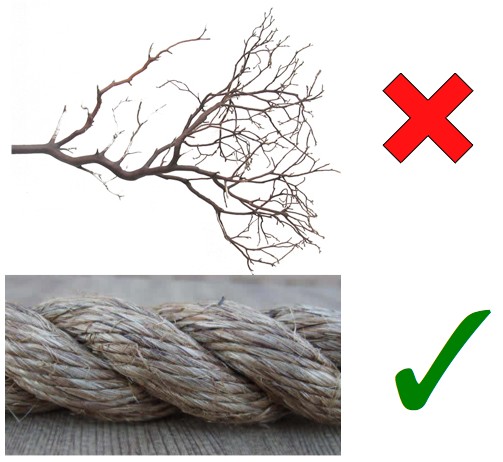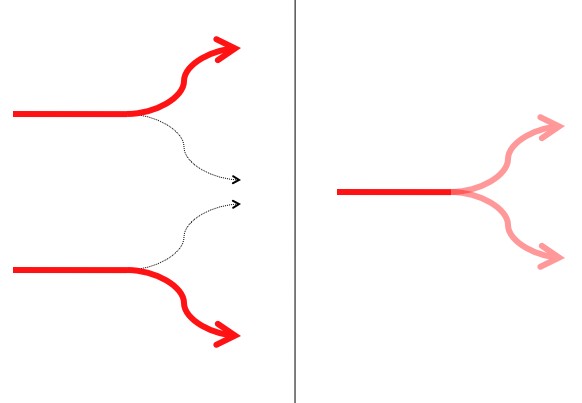Physicist: There is no new energy or matter (or even new universes), it’s just that how it’s distributed depends on who’s asking, and in what “world” they’re doing the asking. The important thing is: the universe doesn’t split or spawn new universes.
For those not familiar, here’s the crux of the problem. If you don’t interact with (measure) things they behave like waves and can be in many places and do many things. But when you do interact with a thing, it suddenly seems to only be in one state. The double slit experiment is the classic example. There are a couple of ways to explain this: the Copenhagen interpretation, psychic powers, Spaghetti Monsters, the Many World Interpretation, and a few others that are a little far-fetched.
If you go online (or read some kind of book or something) you generally find the Many Worlds Interpretation presented as the universe “splitting”. Something along the lines of “everything that can happen will, just in different universes”.
From howstuffworks.com: “When a physicist measures the object, the universe splits into two distinct universes to accommodate each of the possible outcomes.”
From about.com: “…every time a ‘random’ event takes place, the universe splits between the various options available. Each separate version of the universe contains a different outcome of that event. Instead of one continuous timeline, the universe under the many worlds interpretation looks more like a series of branches splitting off of a tree limb.”
Quick aside: I’m about to talk about why this is wrong, but don’t take that as a criticism. The “splitting/branching” thing is about the only narrative anyone ever hears, so I’m not knocking the fine and hard-working people of “about” and “howstuffworks” (or the authors of the hundreds of other examples out there). Much respect.
So, supposedly every time any kind of quantum event happens that could have one of several results (which is essentially every moment for every thing, which is plenty) the entire freaking universe splits into many universes. But, the universe contains a lot of energy. Like, even more than the U.S. uses in a year. So, whence does this energy come?
First off, in a not-really-explaining-anything nutshell: the universe doesn’t branch so much as it meanders and intertwines. This isn’t an answer to the energy question, but it’s worth mentioning.

If you want a picture to work with, rather than thinking about the universe as an ever-branching tree, think of it as an intertwining (albeit, very complex) rope.
The many (like: many, many) different versions of the universe branch apart, and come together all over the place. That is; one event can certainly lead to several outcomes, but in the same way, several causes can lead to the same event. Everything the could happen will happen (given the present) and everything that could have happened did happen (given the present). You can think of this as un-branching, or branching into the past. Either way. The Franson experiment, which demonstrates a single photon emitted at two different times in the past interfering with itself (isn’t that weird?), is one of the most beautiful examples of this “backward branching”.
That doesn’t answer the question, but it does sorta help set the stage for the universe being more complicated than just “splitting”.
The way that energy is conserved depends on the context of the question. Say you’ve got a particle and at some point, for whatever reason, it finds that it has to take one of two paths. There are a lot of reasons this could happen, but the particulars aren’t important. The cases to consider are: 1) you measure it taking one of the two paths and 2) you don’t.

Although the details change, the total amount of energy stays constant from all perspectives. Both from inside the system (left) where all the energy is concentrated on one of the possible paths, as well as when seen from outside (right) in which the particle and its associated energy can be distributed among the different paths.
If you’re “caught up” with the particle in question, maybe by observing it / interacting with it, you find that it only takes one path (More accurately, each of the different versions of you see each of the different versions of the particle taking one path). You’ll see the particle start out, “choose” between the upper and lower paths (a random choice), and continue on. From your perspective the total energy never changes. You may have a sneaking suspicion that there are other quantum worlds, but you never (none of your versions ever) actually see a problem. To have a problem you’d need to be able to see more than one of the particle’s “worlds”.
But that’s no problem! Seeing a particle in multiple states (each of which is a different “world” to the particle) is the oldest trick in the quantum book. This, by the way, is one of the great weakness of the language involved. You’d think that “worlds” and “universes” would have to be completely separate. But while the different states of the particle each see each other as being in different worlds, for something that sees the super-position of all those states (for example, something that sees the interference fringes in the double slit experiment) they seem to be in the same world.
When a particle (or whatever) is in multiple states its energy and matter is distributed among those various states. In the two-equally-probable-paths example above, half of particle’s existence takes one path and half takes the other. Likewise, its energy and matter are divided among the paths.
Although you can’t measure “half a particle” (a particle’s nature is to be indivisible), you can show that particles often need to be in multiple states (so their existence can be spread out), and you can even calculate and measure how much of each particle must be taking various paths. Again, the double slit experiment is an excellent example.
So, in the two-path example, a particle comes along with some amount of energy. When it has a choice of two paths it takes both. The energy of the particle is divided in proportion to the probability of the path taken. So, for example, 50% chance of each path means equal division of the energy and matter of the particle. Before the fork all of the energy is on one path, and afterwards, despite the fact that the particle is behaving as though it’s in two places, the same amount of energy is present, just spread out.
It may seem deeply weird to say that, but you could argue that no particle keeps all its matter/energy/existence in one place at a time. For example, if you look at an electron in an atom you find that it’s smeared out around the nucleus in the form of an “electron cloud”. Electrons don’t orbit atoms like planets around the Sun, they “wave” around the nucleus like vibrations in a ringing bell.
That, and other terrible similes, will be included in my upcoming book, “some thing are like these other things, but different, y’know?: a book that’s like a collection of similes”.

Each electron in an atom forms a "cloud" around the nucleus. Literally, it is in every possible position (some more than others). The nucleus itself takes the form of proton and neutron clouds, they're just much, much smaller.
For “uncertainty principle” type reasons, electrons (and everything else) always exist in a “cloud” of locations, all at once. You can say “there is an electron around this atom” and you can say “the energy and matter of the electron is around this atom”, but there’s nothing you can say past that. The existence of the electron, and everything else about it, is spread out.
Each different version of a thing, and every “parallel world” may see itself as holding all of its energy and matter, but from an outside perspective (where the “many-worldness” becomes important) it’s just part of a greater whole. Either way, energy is always conserved. So, while it’s fun to talk about “other quantum realities” and “different universes”, it’s more accurate to say that everything is happening in one universe. One, stunningly complex, weirdly put together, entirely counter-intuitive universe.







Pingback: Clearing Up This Multiple Universe Thing (Maybe) | Whereof One Can Speak